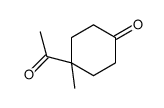5122-77-0
| Name | 4-hydroxy-1-methylbicyclo[2.2.2]octan-2-one |
|---|---|
| Synonyms |
HMS548E04
1-Hydroxy-4-methylbicyclo[2.2.2]octan-3-one |
| Density | 1.224 g/cm3 |
|---|---|
| Boiling Point | 252ºC at 760 mmHg |
| Melting Point | 55-56ºC |
| Molecular Formula | C9H14O2 |
| Molecular Weight | 154.20600 |
| Flash Point | 104ºC |
| Exact Mass | 154.09900 |
| PSA | 37.30000 |
| LogP | 1.27060 |
| Index of Refraction | 1.567 |
Synonym: Section 2 - COMPOSITION, INFORMATION ON INGREDIENTS
Risk Phrases: 36/37/38 Section 3 - HAZARDS IDENTIFICATION EMERGENCY OVERVIEW
Irritating to eyes, respiratory system and skin. Potential Health Effects Eye: Causes eye irritation. Skin: Causes skin irritation. May be harmful if absorbed through the skin. Ingestion: May cause irritation of the digestive tract. May be harmful if swallowed. Inhalation: Causes respiratory tract irritation. May be harmful if inhaled. Chronic: Not available. Section 4 - FIRST AID MEASURES Eyes: Flush eyes with plenty of water for at least 15 minutes, occasionally lifting the upper and lower eyelids. Get medical aid. Skin: Get medical aid. Flush skin with plenty of water for at least 15 minutes while removing contaminated clothing and shoes. Ingestion: Get medical aid. Wash mouth out with water. Inhalation: Remove from exposure and move to fresh air immediately. If not breathing, give artificial respiration. If breathing is difficult, give oxygen. Get medical aid. Notes to Physician: Treat symptomatically and supportively. Section 5 - FIRE FIGHTING MEASURES General Information: As in any fire, wear a self-contained breathing apparatus in pressure-demand, MSHA/NIOSH (approved or equivalent), and full protective gear. Extinguishing Media: Use water spray, dry chemical, carbon dioxide, or chemical foam. Section 6 - ACCIDENTAL RELEASE MEASURES General Information: Use proper personal protective equipment as indicated in Section 8. Spills/Leaks: Vacuum or sweep up material and place into a suitable disposal container. Section 7 - HANDLING and STORAGE Handling: Avoid breathing dust, vapor, mist, or gas. Avoid contact with skin and eyes. Storage: Store in a cool, dry place. Store in a tightly closed container. Section 8 - EXPOSURE CONTROLS, PERSONAL PROTECTION Engineering Controls: Facilities storing or utilizing this material should be equipped with an eyewash facility and a safety shower. Use adequate ventilation to keep airborne concentrations low. Exposure Limits CAS# 5122-77-0: Personal Protective Equipment Eyes: Not available. Skin: Wear appropriate protective gloves to prevent skin exposure. Clothing: Wear appropriate protective clothing to prevent skin exposure. Respirators: Follow the OSHA respirator regulations found in 29 CFR 1910.134 or European Standard EN 149. Use a NIOSH/MSHA or European Standard EN 149 approved respirator if exposure limits are exceeded or if irritation or other symptoms are experienced. Section 9 - PHYSICAL AND CHEMICAL PROPERTIES Physical State: Solid Color: cream Odor: Not available. pH: Not available. Vapor Pressure: Not available. Viscosity: Not available. Boiling Point: Not available. Freezing/Melting Point: 55 - 56 deg C Autoignition Temperature: Not available. Flash Point: Not available. Explosion Limits, lower: Not available. Explosion Limits, upper: Not available. Decomposition Temperature: Solubility in water: Specific Gravity/Density: Molecular Formula: C9H14O2 Molecular Weight: 154 Section 10 - STABILITY AND REACTIVITY Chemical Stability: Not available. Conditions to Avoid: Incompatible materials. Incompatibilities with Other Materials: Oxidizing agents. Hazardous Decomposition Products: Carbon monoxide, carbon dioxide, acrid smoke and fumes. Hazardous Polymerization: Has not been reported Section 11 - TOXICOLOGICAL INFORMATION RTECS#: CAS# 5122-77-0 unlisted. LD50/LC50: Not available. Carcinogenicity: 4-Hydroxy-1-methylbicyclo[2.2.2]octan-2-one - Not listed by ACGIH, IARC, or NTP. Section 12 - ECOLOGICAL INFORMATION Section 13 - DISPOSAL CONSIDERATIONS Dispose of in a manner consistent with federal, state, and local regulations. Section 14 - TRANSPORT INFORMATION IATA No information available. IMO No information available. RID/ADR No information available. Section 15 - REGULATORY INFORMATION European/International Regulations European Labeling in Accordance with EC Directives Hazard Symbols: XI Risk Phrases: R 36/37/38 Irritating to eyes, respiratory system and skin. Safety Phrases: S 26 In case of contact with eyes, rinse immediately with plenty of water and seek medical advice. S 37/39 Wear suitable gloves and eye/face protection. WGK (Water Danger/Protection) CAS# 5122-77-0: No information available. Canada None of the chemicals in this product are listed on the DSL/NDSL list. CAS# 5122-77-0 is not listed on Canada's Ingredient Disclosure List. US FEDERAL TSCA CAS# 5122-77-0 is not listed on the TSCA inventory. It is for research and development use only. SECTION 16 - ADDITIONAL INFORMATION N/A |
| Hazard Codes | Xi: Irritant; |
|---|---|
| Risk Phrases | R36/37/38 |
| Safety Phrases | 26-36/37/39 |
| HS Code | 2914400090 |
|
~73% 
5122-77-0 |
| Literature: Gray, George W.; Kelly, Stephen M. Journal of the Chemical Society, Perkin Transactions 2: Physical Organic Chemistry (1972-1999), 1981 , p. 26 - 31 |
|
~% 
5122-77-0 |
| Literature: Colonge,J.; Vuillemet,R. Bulletin de la Societe Chimique de France, 1961 , p. 2235 - 2236 |
|
~% 
5122-77-0 |
| Literature: Kraus,W. et al. Tetrahedron, 1969 , vol. 25, p. 3681 - 3692 |
|
~% 
5122-77-0 |
| Literature: Morita,K.-I. et al. Journal of Organic Chemistry, 1965 , vol. 30, p. 533 - 538 |
| Precursor 3 | |
|---|---|
| DownStream 1 | |
| HS Code | 2914400090 |
|---|---|
| Summary | 2914400090 other ketone-alcohols and ketone-aldehydes。Supervision conditions:None。VAT:17.0%。Tax rebate rate:9.0%。MFN tariff:5.5%。General tariff:30.0% |




![1-chloro-4-methyl-bicyclo[2.2.2]octan-3-one structure](https://image.chemsrc.com/caspic/191/7697-12-3.png)